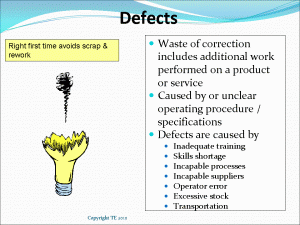The Waste of Defects
Defects are one of the seven wastes of lean manufacturing or 7 mudas, defects are when products or service deviate from what the customer requires or the specification. When you talk about waste most people think of defects rather than the other wastes such as waiting and transportation.
The Costs of the waste of Defects
There has been much written regarding the cost of defectives, the reason being that the cost is not always what we perceive it to be. The cost of rejects and rework are often compared to an iceberg; only a small fraction of the true cost being visible above the water level.
In addition to the obvious cost of the initial scrap item we have a number of other costs that are not always obvious or considered although frequently far in excess of this initial cost. The general rule of thumb is to multiply the cost of the scrap by a factor of ten to arrive at the true cost to your business.
There are costs associated with problem solving, materials, rework, rescheduling materials, setups, transport, paperwork, increased lead times, delivery failures and potentially lost customers who will take their custom elsewhere.
Causes of the Waste of Defects.
Defects can be caused by many different problems, many that should be avoidable with a little thought when designing your products, processes and equipment.
Many defects are caused by incorrect method due to non-standard operations, differences in the way that processes are undertaken by different operators on different shifts.
We also build the opportunity for errors into our products by failing to think about how items can be assembled when we design them, we have components that can be assembled incorrectly if the operators do not align them correctly and so on.
We fail to maintain our equipment, machines and fixtures allowing defects to occur.
We don’t have a culture that empowers and makes our operators confident enough to highlight problems and allow them to be solved, they often continue and make the best of a poorly fitting component rather than stopping to have either the fixtures or the components corrected.
We don’t provide training to our people; we throw them straight in at the deep end and tell them to do the same as the guy stood beside them, often the one that was thrown in there the week before.
We also reward the wrong behaviors, paying for quantity rather than quality, encouraging our employees to work as fast as possible and even penalizing them if they do not make the numbers with little thought to the consequences on the quality of our products or services.
Examples of wastes of Defects
- Scrap produced by poorly maintained fixtures.
- Parts assembled with the incorrect orientation.
- Missing screws and other fixing due to lack of controls.
- Incorrect components used due to incorrect, or missing instructions.
- Poorly made components that continued to be made as the employees wanted to reach their performance bonus.
- Parts damaged due to excessive handling.
- Faulty parts that have reached the customer.
How to eliminate or reduce Defects
There are many techniques out there to help you to identify and eliminate wastes; however within lean manufacturing we wish to prevent them occurring in the first place.
This prevention of defects is achieved by a number of different techniques from autonomation / Jidoka (Machines with “human” intelligence that are able to detect when a non standard event has occurred) through to Pokayoke devices that detect if a product is defective, either preventing the process from running or highlighting the defect for action.
We also implement standard operations procedures (SOP) and training to ensure that the correct methods are undertaken and standards achieved.
The most important factor however is the empowerment of teams to solve and prevent their own problems. By harnessing the talents of your employees you are able to quickly and efficiently prevent the occurrence of defects.
Improve profit through waste reduction.
By reducing defects from your processes you will reduce your costs, and every saving you make within your costs is added directly to your profits. So the harder you work at reducing the muda, muri and mura within your processes by applying the principles of lean manufacturing the sooner you can realize the true benefits of lean manufacturing for your organization. This will allow you not just to survive as a business but to thrive in today’s global markets.
Removal of the waste of defects and the other wastes of lean manufacturing will help you to achieve these goals;
- Reduce all of the raw materials, work in progress and finished goods to eliminate the waste of Inventory.
- Prevent people from waiting for materials, information or instructions to eliminate the waste of waiting.
- Become more ergonomic and reduce excessive motion to reduce the waste of motion.
- Make product when required by the customer in the quantities requested to eliminate the waste of overproduction.
- Don’t do more to a product than required by the customer to reduce the waste of overprocessing.
- Don’t waste your resources such as gas, electricity and water to reduce the waste of resources.
- Involve and respect your employees to reduce the waste of people in your business.
- Reduce the transportation of goods within your organization to reduce the waste of transport.


1 comment for “Waste of Defects; causes, symptoms, examples and solutions”